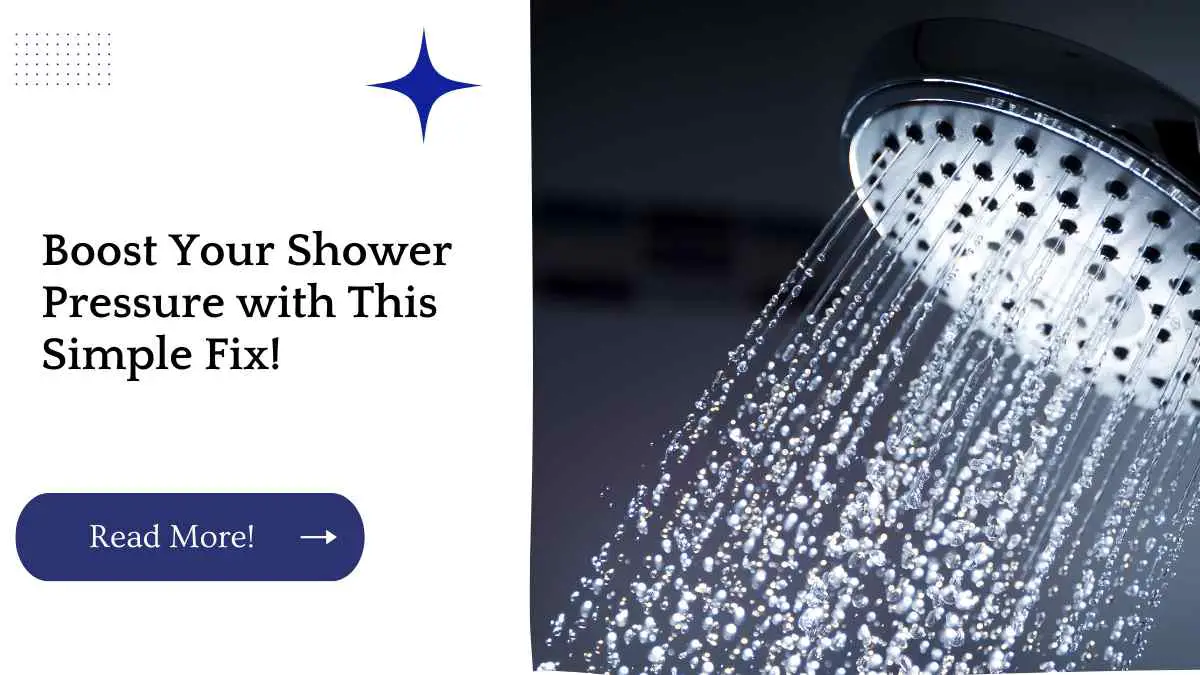Taking a shower is a daily ritual for most people. Whether it’s to wake you up in the morning or to relax after a long day, a shower is a chance to cleanse and rejuvenate. However, when the water pressure is low, it can make the showering experience frustrating and unsatisfying.
Fortunately, there are simple ways to fix low shower pressure that can make your showering experience enjoyable again.
| Takeaways |
|---|
| Weak shower pressure can be caused by clogged showerheads, low water pressure, or leaks in pipes. |
| Signs of low shower pressure include slow water flow, difficulty rinsing soap or shampoo, and weak water flow. |
| Simple fix involves cleaning or replacing the showerhead, installing a pressure-boosting showerhead, or adjusting the water pressure regulator valve. |
| To maintain consistent pressure, regularly clean the showerhead, check for leaks, and ensure water pressure from the main supply is adequate. |
| Boosting shower pressure provides a more satisfying shower experience, faster rinsing, improved hygiene, and increased water efficiency. |
What causes low water pressure in your shower?
There are several reasons why your shower may have low water pressure. The most common reasons include:
- Clogged showerheads: Mineral deposits and debris can accumulate in the showerhead, blocking the water flow and causing low pressure.
- Low water pressure from the main supply: If the water pressure from the main supply is low, it will affect the water pressure in your shower.
- Leaks in the pipes: If there are leaks in the pipes leading to your shower, it can cause a drop in water pressure.
Signs of low water pressure in your shower
If you suspect your shower has low water pressure, there are a few signs to look out for. These include:
- A slow trickle of water: If the water flow from your showerhead is slow and weak, it may be a sign of low water pressure.
- Difficulty rinsing shampoo or soap: If you find it difficult to rinse out shampoo or soap from your hair or body, it may be a sign of low water pressure.
- Weak water flow: If the water flow from your showerhead is weak and does not provide adequate pressure, it may be a sign of low water pressure.
Are you tired of taking cold showers in the morning? Don’t worry! Our guide on solving the mystery of no cold water in your shower will help you understand the common causes of this issue and how to fix it easily
How to check your shower’s water pressure
To check your shower’s water pressure, you can use a pressure gauge that can be found at your local hardware store. Simply attach the gauge to your showerhead or faucet and turn on the water. The gauge will provide a reading of your water pressure in pounds per square inch (PSI). A healthy water pressure should be between 40 and 80 PSI.
Simple fix for boosting your shower pressure
There are several ways to fix low shower pressure. The simplest solution is to clean or replace your showerhead. Mineral deposits and debris can accumulate in the showerhead, blocking the water flow and causing low pressure.
To clean the showerhead, remove it from the shower arm and soak it in a solution of vinegar and water for a few hours. Scrub the showerhead with a brush and rinse it with clean water before reattaching it to the shower arm.
Another option is to install a pressure-boosting showerhead. These showerheads are designed to increase water pressure and provide a stronger, more satisfying shower experience. There are several types of pressure-boosting showerheads available, including aerating, laminar flow, and massage showerheads.
If neither of these options works, you may need to adjust the water pressure regulator valve. The valve is usually located near the main water supply line and can be adjusted with a screwdriver. However, it is important to be cautious when adjusting the valve as too much pressure can cause damage to the plumbing.
Enjoying a hot shower can be one of the most relaxing parts of your day. Check out our guide on maximizing your bath time with hot water solutions to learn about different ways to improve your hot water supply and enjoy a spa-like experience at home
Tools and materials you need for the fix
- Vinegar
- Water
- Brush
- Pressure gauge
- Pressure-boosting showerhead
- Screwdriver
Step-by-step guide for fixing low shower pressure
- Turn off the water supply to the shower.
- Remove the showerhead from the shower arm.
- Fill a plastic bag with vinegar and water in a 1:1 ratio and attach it to the showerhead with a rubber band.
- Let the showerhead soak in the solution for a few hours.
- Remove the bag and scrub the showerhead with a brush.
- Rinse the showerhead with clean water and reattach it to the shower arm.
- Turn on the water supply and check the water pressure with a pressure gauge.
If cleaning or replacing the showerhead does not fix the low water pressure, you can install a pressure-boosting showerhead. Simply remove the old showerhead and install the new one according to the manufacturer’s instructions.
If the problem persists, you may need to adjust the water pressure regulator valve. Locate the valve near the main water supply line and use a screwdriver to adjust the valve. However, it is important to be cautious when adjusting the valve as too much pressure can cause damage to the plumbing.
If you’re planning to build your dream shower, you should consider installing it curbless on concrete. Our guide on building a curbless shower on concrete provides step-by-step instructions to help you achieve a modern and minimalist bathroom design
Additional tips for maintaining shower pressure
To maintain a consistent shower pressure, there are a few things you can do:
- Regularly clean the showerhead to remove mineral deposits and debris.
- Check for leaks in the pipes leading to your shower and fix them promptly.
- Ensure the water pressure from the main supply is adequate.
- Install a water pressure regulator valve to regulate the water pressure.
Benefits of boosting shower pressure
Boosting shower pressure can provide several benefits, including:
- A more satisfying shower experience.
- Faster and easier rinsing of shampoo and soap.
- Improved hygiene as it allows for better cleaning of the body.
- Increased water efficiency as a higher water pressure can reduce shower time.
How to enjoy a high-pressure shower experience
To enjoy a high-pressure shower experience, you can try the following:
- Install a pressure-boosting showerhead.
- Adjust the water pressure regulator valve to increase water pressure.
- Clean the showerhead regularly to ensure optimal water flow.
Conclusion
Low shower pressure can be a frustrating problem, but it is a common one that can be easily fixed. By following the steps outlined in this article, you can boost your shower pressure and enjoy a more satisfying shower experience. Regular maintenance and cleaning can also help to maintain a consistent water pressure and prevent future problems.
A level toilet is a crucial element in your bathroom’s plumbing system. Learn more about its importance and how to install it correctly by reading our guide on the importance of a level toilet.
Further Reading
Here are some additional resources that may be helpful in increasing your shower water pressure:
Six Ways to Increase Shower Water Pressure: This article provides six simple and effective ways to increase your shower water pressure, including cleaning the showerhead, removing flow restrictors, and adjusting the water pressure regulator.
How to Increase Water Pressure in Shower: This guide offers step-by-step instructions on how to increase your shower water pressure, including checking the water pressure, cleaning the showerhead, and installing a pressure-boosting showerhead.
How to Increase Water Pressure in Your Shower: This article discusses the common causes of low water pressure in showers and offers several solutions for increasing water pressure, including installing a booster pump or pressure vessel.
Frequently Asked Questions (FAQs)
Q1. Why is my shower pressure low?
A1. Low shower pressure can be caused by several factors, including clogged showerheads, low water pressure from the main supply, or leaks in the pipes.
Q2. How can I check my shower’s water pressure?
A2. You can use a pressure gauge that can be found at your local hardware store. Simply attach the gauge to your showerhead or faucet and turn on the water.
Q3. How can I boost my shower pressure?
A3. There are several ways to boost your shower pressure, including cleaning or replacing your showerhead, installing a pressure-boosting showerhead, or adjusting the water pressure regulator valve.
Is your shower diverter causing you trouble? Our guide on quick and easy fixes for a fallen shower diverter has got you covered. We’ve gathered some simple solutions to help you fix this problem and get back to enjoying your shower in no time.
Q4. How often should I clean my showerhead?
A4. It is recommended to clean your showerhead every three to six months to prevent mineral deposits and debris from building up and causing low water pressure.
Q5. Can low shower pressure cause damage to the plumbing?
A5. Low shower pressure itself does not cause damage to the plumbing, but it can be a sign of leaks or other issues that may cause damage over time.

Hellen James is the author of the blog and a licensed plumber with over 15 years of experience. She shares her knowledge and experience in plumbing and drainage through insightful and informative articles

